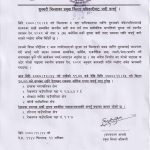Diversity of Local Landraces of Buckwheat in Nepal

Introduction
Buckwheat belongs to a group of foods commonly called pseudocereals. Pseudocereals are seeds that are consumed as cereal grains but don’t grow on grasses. Despite its name, buckwheat is not related to wheat and is thus gluten-free. Buckwheat is a sixth staple food crop after rice, wheat, maize, finger millet, and barley in Nepal. It is considered as an alternate cereal and poor man’s crop, representing an important food supply in remote places of Himalayas. It is the best crop in higher altitude in terms of adaptation to different climatic variables and easily fitted to different cropping patterns due to short duration. Local landraces are traditional crop varieties cultivated in specific locations and constitute a valuable source for breeding purposes towards the creation of elite cultivars and hybrids. The intensification of modern horticulture has put these genotypes aside, since farmers tend to select hybrids.
Local landraces are traditional crop varieties cultivated in specific locations and constitute a valuable source for breeding purposes towards the creation of elite cultivars and hybrids.
Diversity of Local Landraces of Buckwheat in Nepal
So far five species of Fagopyrum (buckwheat), namely, F. esculentum subsp. esculentum, F. tataricum subsp. tataricum, F. tataricum subsp. potanini, F. tataricum subsp. annum, F. cymosum, F. gracilipes, and F. megacarpum, have been reported from Karnali zone with the local names of following buckwheat landraces including crop calendar and productivity from western Nepal.
Mithe Phaper, local chuchche, Local Lekhari, Bhate, Dalle, Kalo, Barule, Takule, Tilkunde, Tote, Ghode, and Tite Phaper are the names of local landraces recorded from Karnali zone and seeding time varies from Jestha, Ashad, and Srawan months and harvesting time from Bhadra, Aswin, and Kartik months, respectively. The productivity of these varieties varies from district to districts and also depends upon the type of local varieties.
Local landraces of buckwheat from Jumla districts of Karnali zone from Nepal include Barule, Bharule, Chuchche, Chode, Kalo, Mithe, Seto, Tilkhude, Tite, and Tote Phaper.
The main morphological characters of some preferred local landraces of buckwheat are:
Mithe Phapar
Mithe Phapar having red stem and leaf, tall plant with white flower and shiny black triangular large seed are tasty, thick husk, lodging resistance, and good for dizziness disease but farmers dislike their low grain yield straw which is not good for livestock.
Barule Phaper
Barule Phaper having medium plant and leaves size and seeds without pointing are of high yielding, short duration variety, leaf useful for vegetables, more branching, and more flour yield, do not need of intercultural operations, are useful for livestock, and are good for pregnant livestock; those are the liked traits, but bitterness, flour that come out from seeds when rainfall occurs after maturity, and difficulty to grind when eating more which can create swelling problem are disliked traits.
Chuchche Phaper
Chuchche Phaper, tall pant with triangular leaf of low branching with long triangular seeds, are liked by farmers due to its low cost of intercultural operations, leaves that are useful for fresh and dry vegetables, high yield, early maturity, usefulness for cough, jaundice, and diabetes diseases, low weed problems, and usefulness for sick animals and animals during bleeding but they are disliked due to their bitterness, causing headache, turning eye yellow, and swelling the body when eating more, no seed set in case of high moisture and fertile soil, and lodging problem in fertile soil.
Conclusion
The agricultural land of Nepal is very diverse due to varied physiography. The cropping pattern is varied in different region of Nepal; it also depends on elevation, culture, and agriculture practices of ethnic communities. Sixty-five percentage of total population still depend on agriculture and contributed 36% for National GDP. Buckwheat is one of the major crops in high mountain of Nepal and cultivated in 61 out of 75 districts ranging from 60 m to 4500 m altitude, especially Rukum, Rolpa, Jajarkot, Dolakha, Solukhumbu, Kalikot, Kavre, and Okhaldhunga districts as well in the districts of Karnali zones of western Nepal. It is summer crop in hill (high altitude > 1700 m asl), autumn and spring crop in mid-hills (600–1700 m asl), and winter crop in Terai.
Buckwheat is multiple useful crop plant with medicinal value and all its parts (roots, stem, leaves, flower, fruits, and flour) are used to care various alignments (diseases) locally in traditional healthcare system. The demand of buckwheat is increasing nowadays due to its multiple uses. Buckwheat is richer in minerals than many other pseudocereals and cereals. It’s high in manganese, copper, and magnesium but low in most vitamins.
Writer: Amrit Gyawali (Student, Bsc. Ag IAAS Paklihawa Campus)

 एउटा यस्तो विषालु भ्यागुता, जसको मुल्य नै पर्छ ३ लाख, जान्नुहाेस्
एउटा यस्तो विषालु भ्यागुता, जसको मुल्य नै पर्छ ३ लाख, जान्नुहाेस्  भोलि र पर्सि बालबालिकालाई भिटामिन ए खुवाइदै
भोलि र पर्सि बालबालिकालाई भिटामिन ए खुवाइदै  खगराज अधिकारी गण्डकीको मुख्यमन्त्री नियुक्त
खगराज अधिकारी गण्डकीको मुख्यमन्त्री नियुक्त  सुनसरीमा दुवै पक्षबीच सहमति, कर्फ्यु खुकुलो हुदै
सुनसरीमा दुवै पक्षबीच सहमति, कर्फ्यु खुकुलो हुदै  स्टेफेनको शतकमा आयरल्याण्ड वोल्भ्सले नेपाल ए लाई दियो २८५ रनको लक्ष्य
स्टेफेनको शतकमा आयरल्याण्ड वोल्भ्सले नेपाल ए लाई दियो २८५ रनको लक्ष्य 



[…] person who desire to obtain patent right of any local landraces should register it in their name under the provision of “The Patent, Design and Trade Mark Act, […]